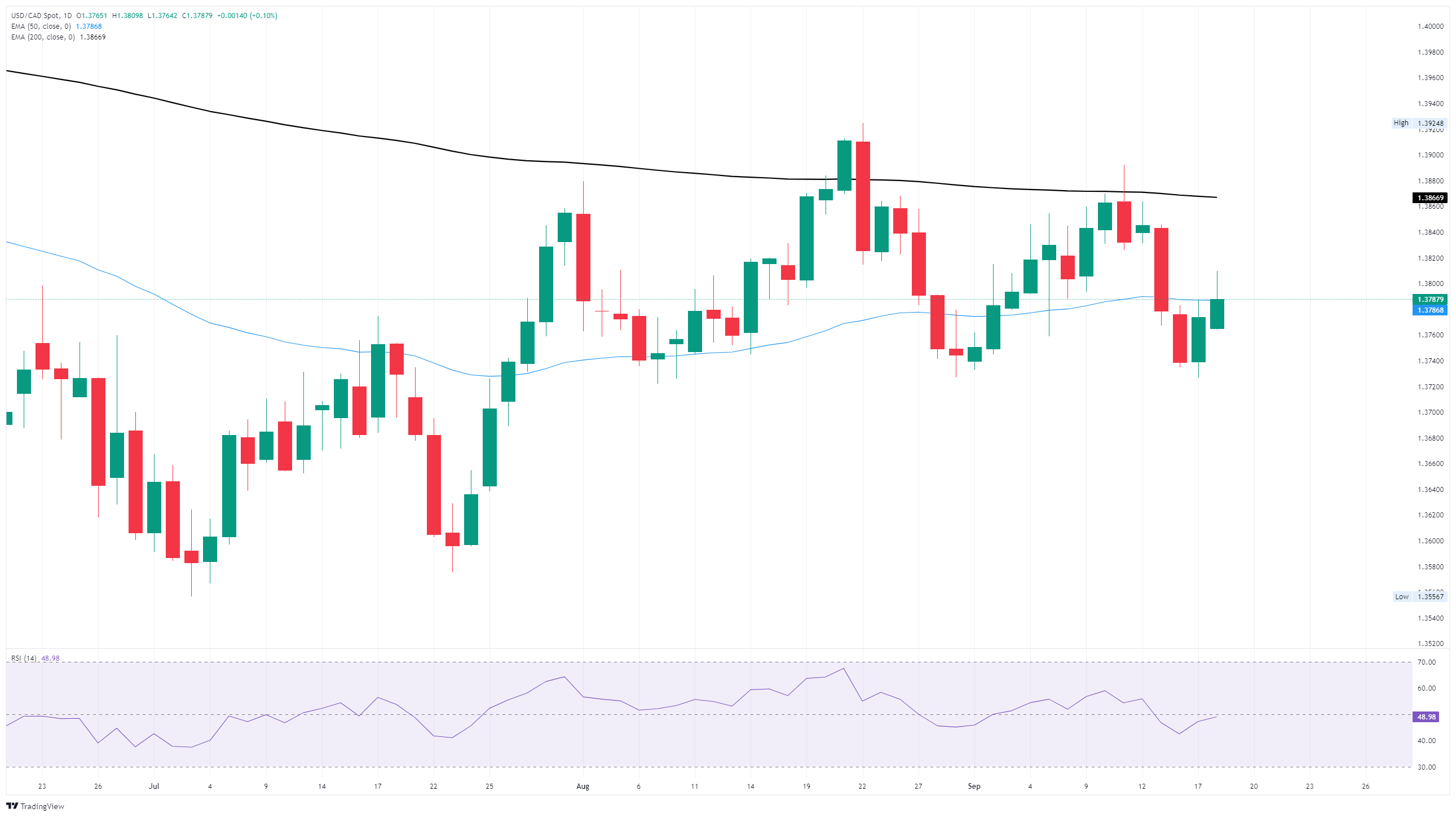Canadian Dollar pares away more gains as US Dollar recovers ground
- The Canadian Dollar drifted lower on Thursday, falling back against the US Dollar.
- Greenback flows have dominated USD/CAD, leaving the Loonie in a data-light lurch.
- Despite market jubilation about rate cuts, manic investors remain leery.
The Canadian Dollar (CAD) stumbled into a second straight day of declines on Thursday. The US Dollar (USD) continues to gain ground despite a fresh interest rate cut from the Federal Reserve (Fed), as market tensions surrounding shaky US economic conditions and still-high Treasury yields keep the safe-haven Greenback well-bid.
The Bank of Canada (BoC) delivered its own quarter-point interest rate cut this week, kicking out what little support the Loonie had against the US Dollar. Rate markets are now sceptical about the BoC’s ability to deliver further economy-supporting rate trims looking forward, with the Canadian economy grappling with flagging data releases and recession concerns buoyed into the high end.
Daily digest market movers: Canadian Dollar falls back as central banks race rate cuts
- The Canadian Dollar fell around one-sixth of one percent against the US Dollar on Thursday.
- The Loonie’s two-day decline has extended to 0.6% top-to-bottom.
- Despite near-term declines, the Canadian Dollar is still trading within a comfortable range against the US Dollar.
- The BoC and the Fed both delivered quarter-point rate cuts this week, and it now comes down to which CB will deliver further rate cuts through the remainder of the year.
- General market sentiment adds complexity to the rate differential. Greenback flows remain elevated despite Fed rate cuts, as Treasury yields remain high. Ongoing weakness in US economic data could see the US Dollar climb further despite rate cuts as risk aversion returns to markets.
Canadian Dollar price forecast
The Canadian Dollar has eased back against the US Dollar heading through the midweek, sending USD/CAD higher after a third straight bounce from a technical support zone near 1.3740. The pair is now back into a congestion point at the 50-day Exponential Moving Average (EMA) near 1.3790, and near-term price action is struggling to find meaningful momentum on either side of the 1.3800 handle.
USD/CAD daily chart

Canadian Dollar FAQs
The key factors driving the Canadian Dollar (CAD) are the level of interest rates set by the Bank of Canada (BoC), the price of Oil, Canada’s largest export, the health of its economy, inflation and the Trade Balance, which is the difference between the value of Canada’s exports versus its imports. Other factors include market sentiment – whether investors are taking on more risky assets (risk-on) or seeking safe-havens (risk-off) – with risk-on being CAD-positive. As its largest trading partner, the health of the US economy is also a key factor influencing the Canadian Dollar.
The Bank of Canada (BoC) has a significant influence on the Canadian Dollar by setting the level of interest rates that banks can lend to one another. This influences the level of interest rates for everyone. The main goal of the BoC is to maintain inflation at 1-3% by adjusting interest rates up or down. Relatively higher interest rates tend to be positive for the CAD. The Bank of Canada can also use quantitative easing and tightening to influence credit conditions, with the former CAD-negative and the latter CAD-positive.
The price of Oil is a key factor impacting the value of the Canadian Dollar. Petroleum is Canada’s biggest export, so Oil price tends to have an immediate impact on the CAD value. Generally, if Oil price rises CAD also goes up, as aggregate demand for the currency increases. The opposite is the case if the price of Oil falls. Higher Oil prices also tend to result in a greater likelihood of a positive Trade Balance, which is also supportive of the CAD.
While inflation had always traditionally been thought of as a negative factor for a currency since it lowers the value of money, the opposite has actually been the case in modern times with the relaxation of cross-border capital controls. Higher inflation tends to lead central banks to put up interest rates which attracts more capital inflows from global investors seeking a lucrative place to keep their money. This increases demand for the local currency, which in Canada’s case is the Canadian Dollar.
Macroeconomic data releases gauge the health of the economy and can have an impact on the Canadian Dollar. Indicators such as GDP, Manufacturing and Services PMIs, employment, and consumer sentiment surveys can all influence the direction of the CAD. A strong economy is good for the Canadian Dollar. Not only does it attract more foreign investment but it may encourage the Bank of Canada to put up interest rates, leading to a stronger currency. If economic data is weak, however, the CAD is likely to fall.
